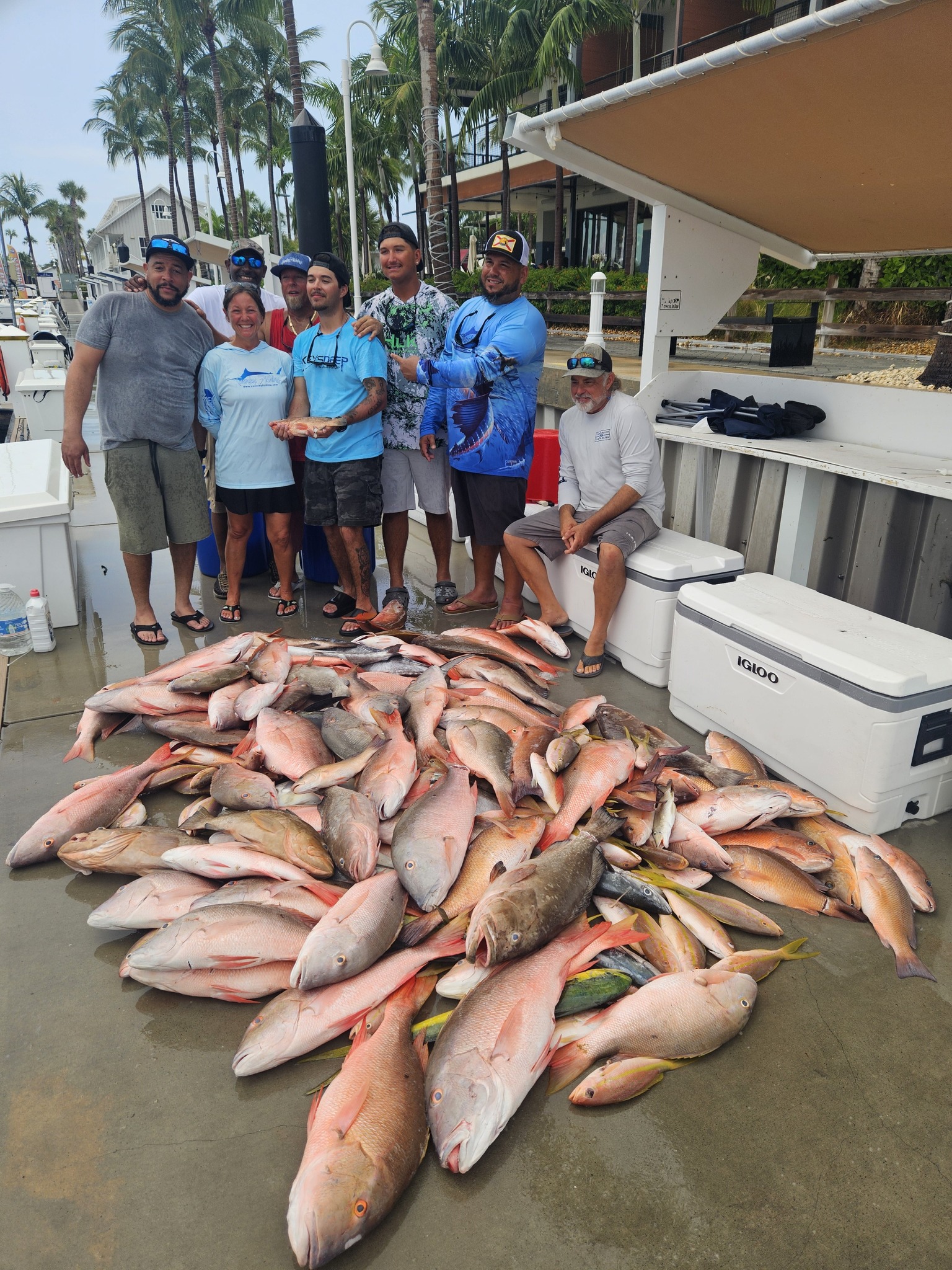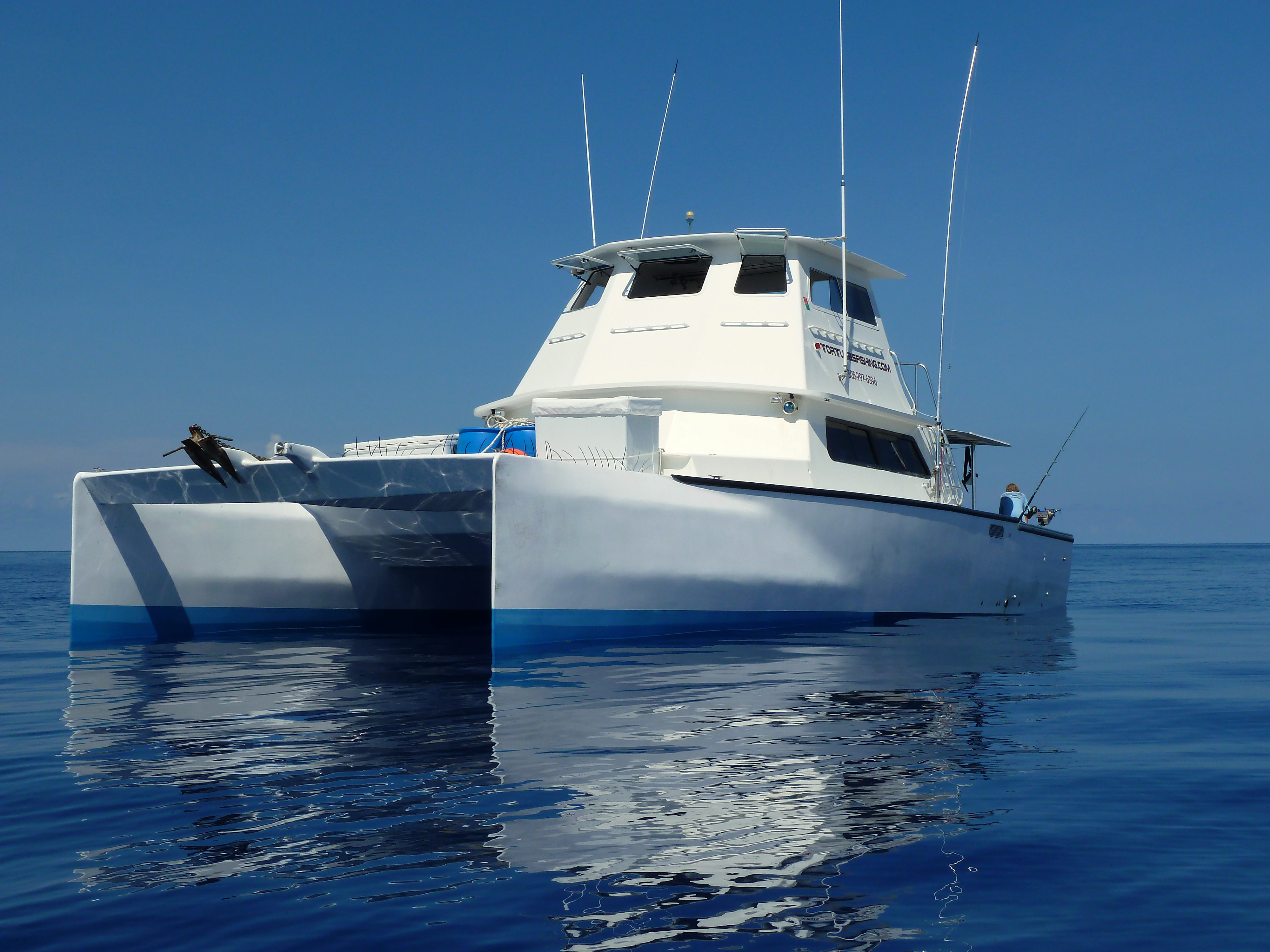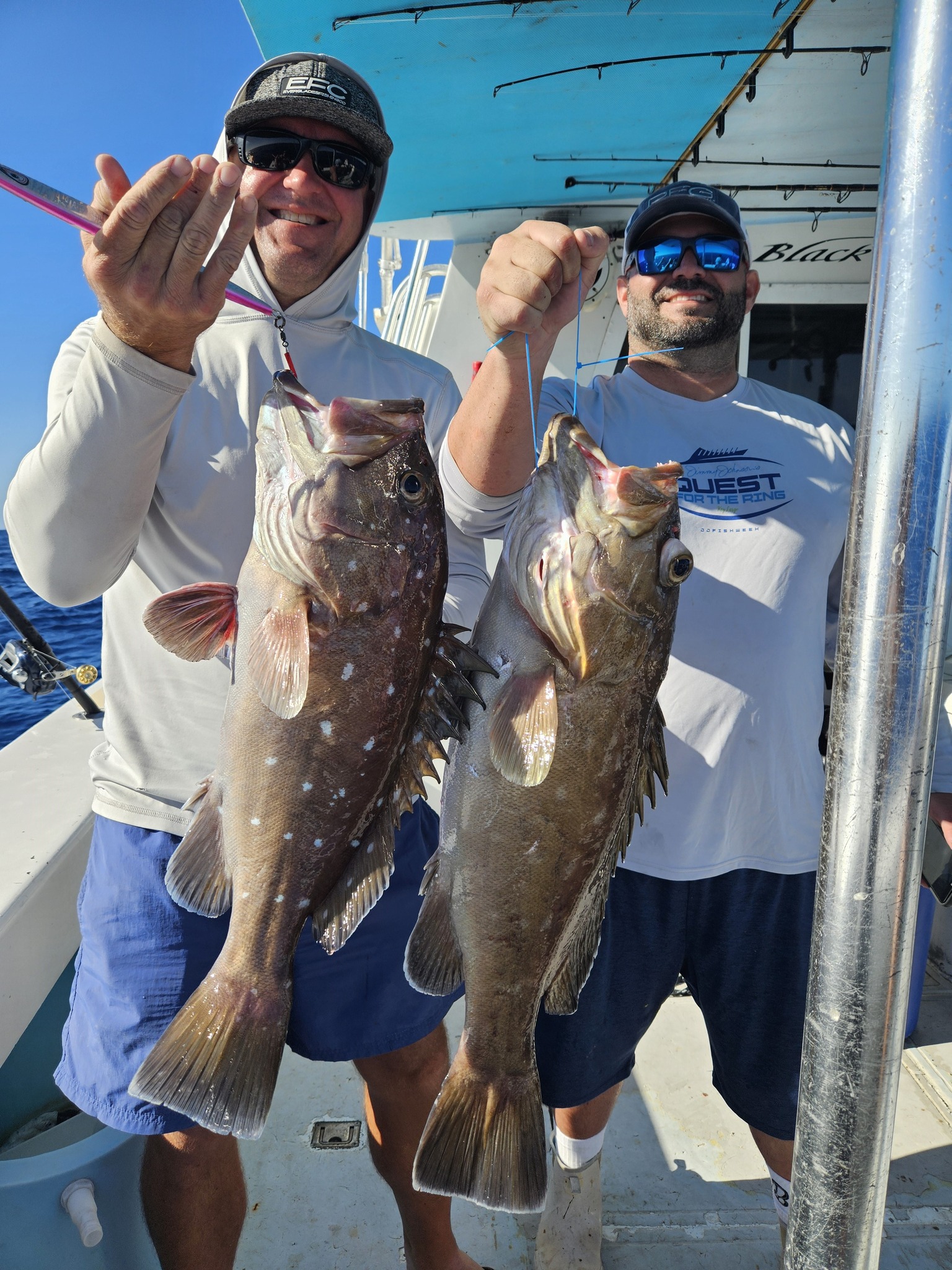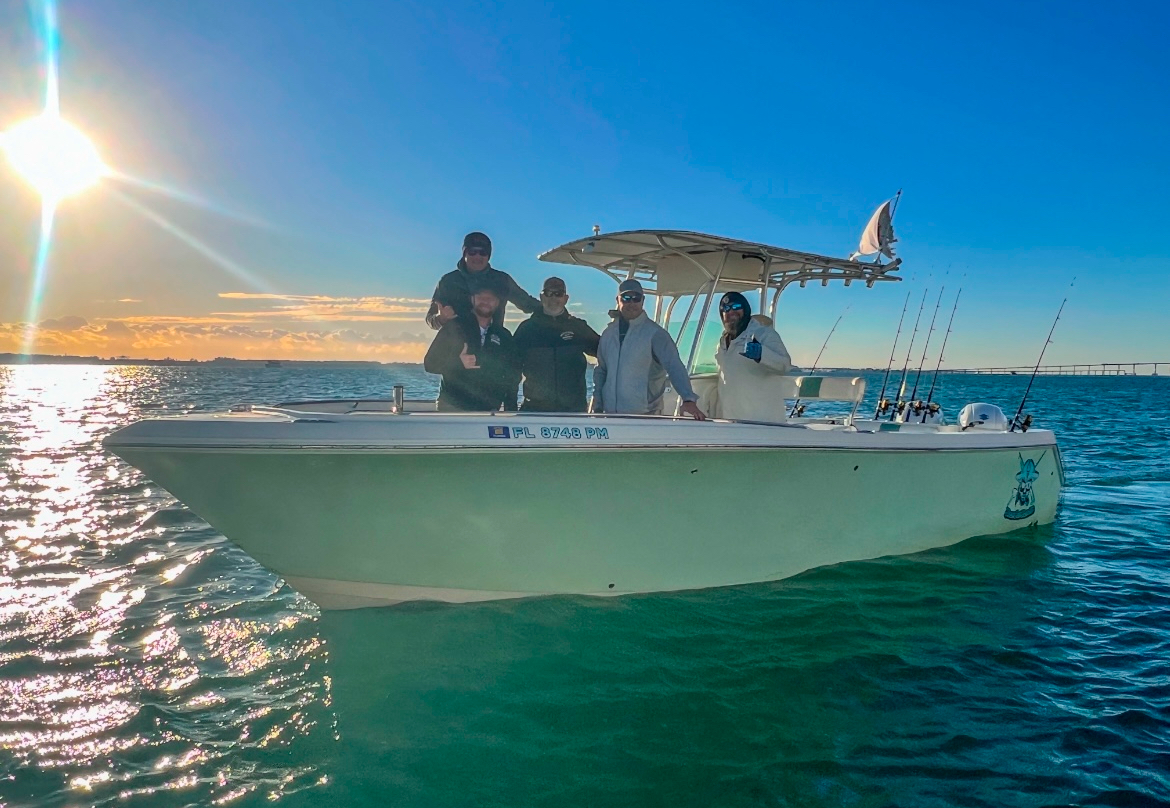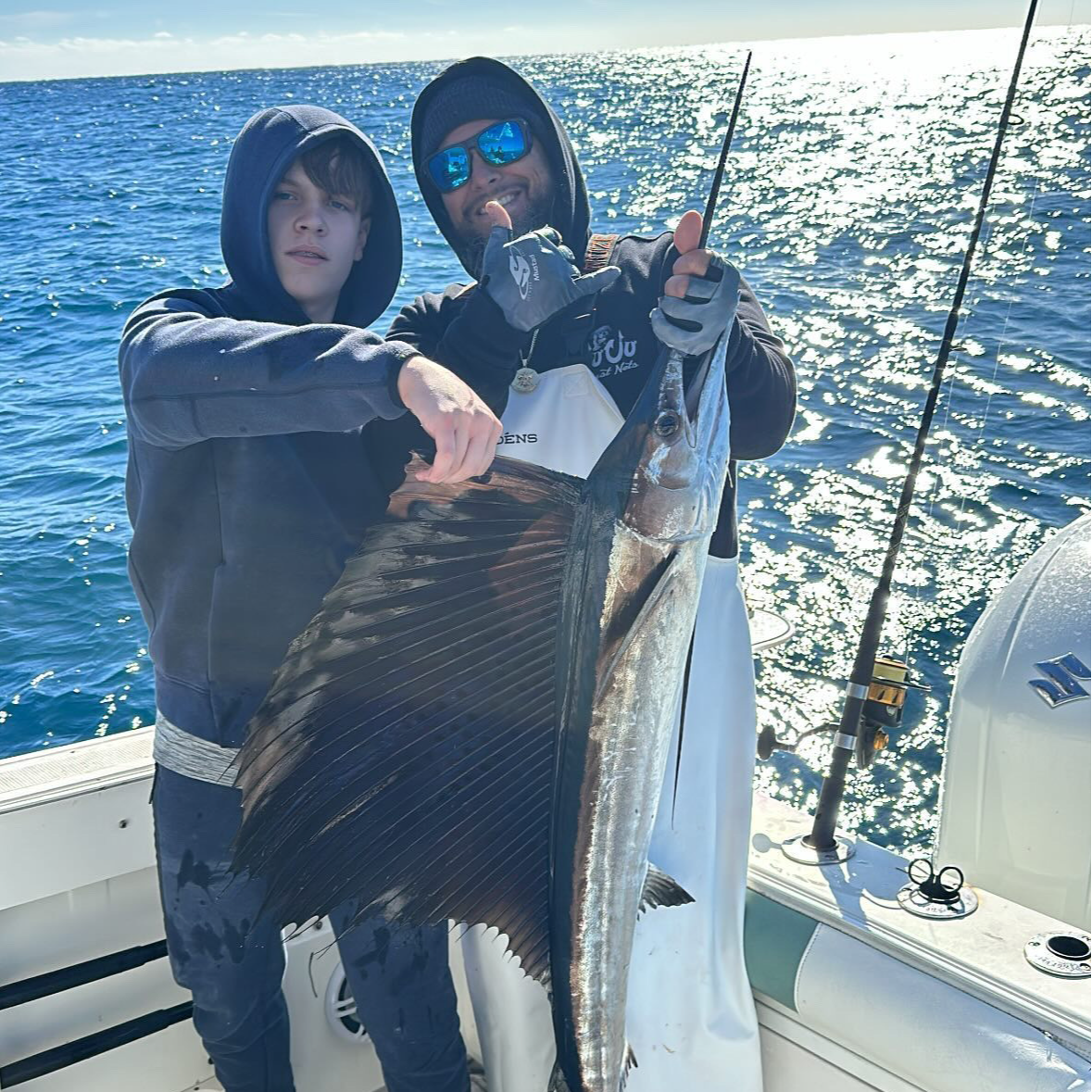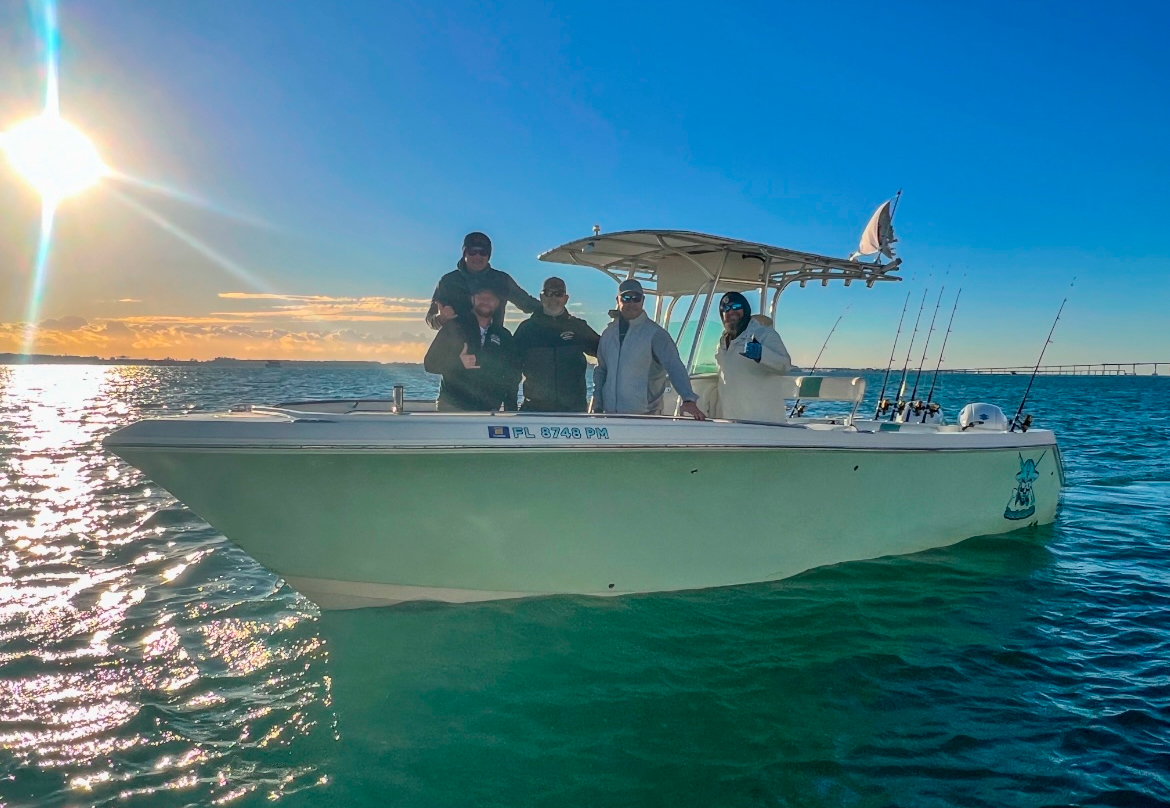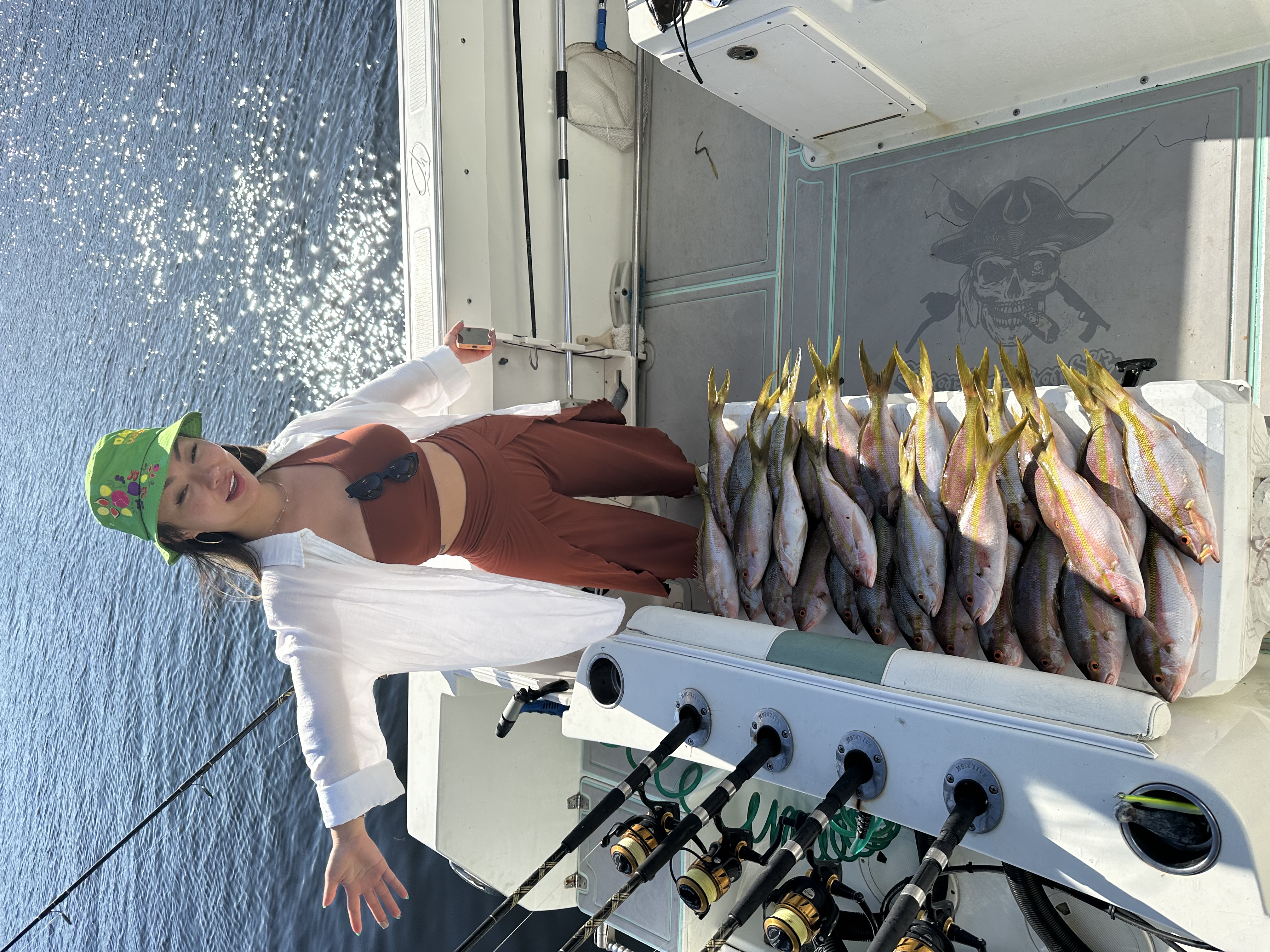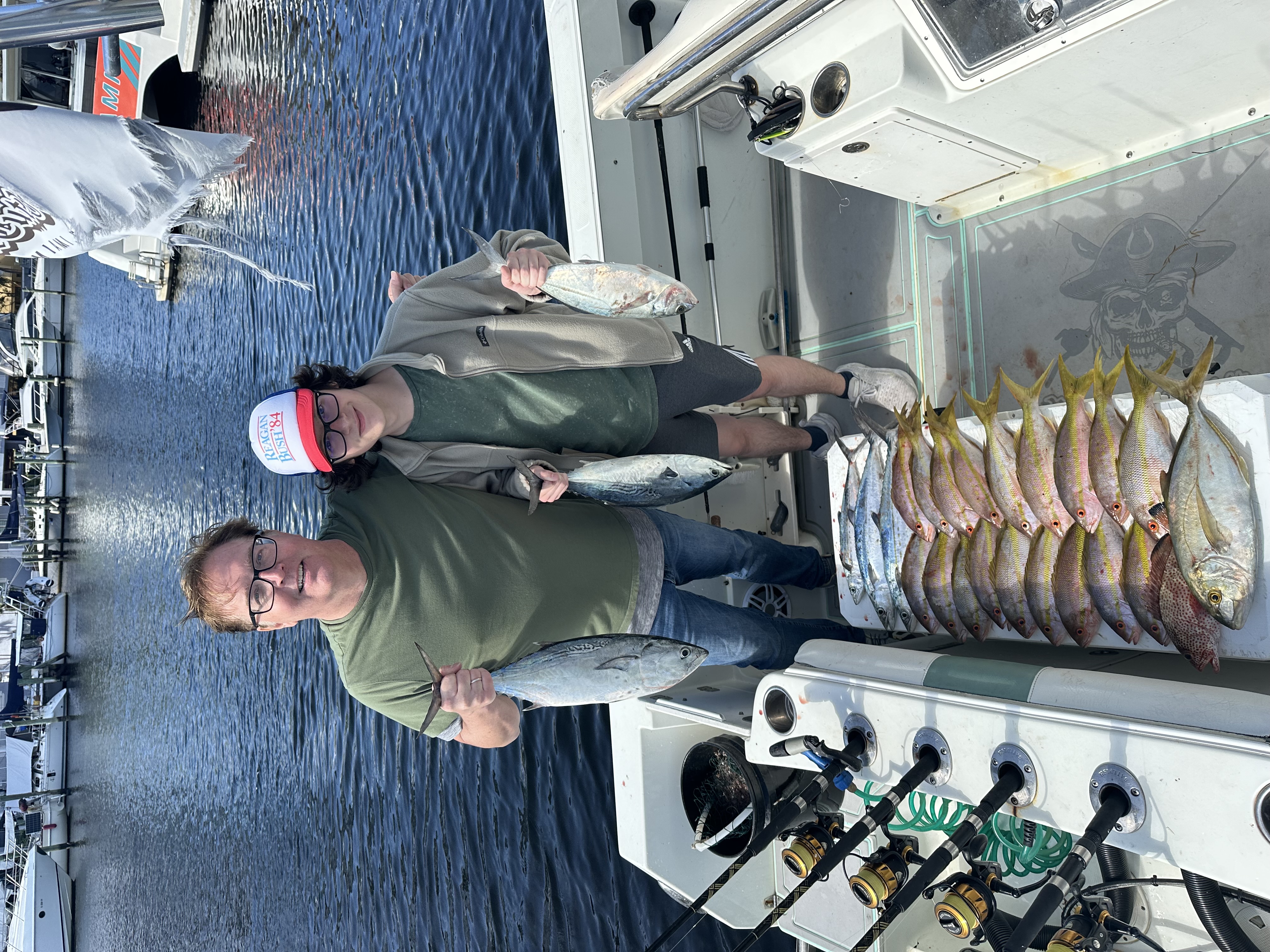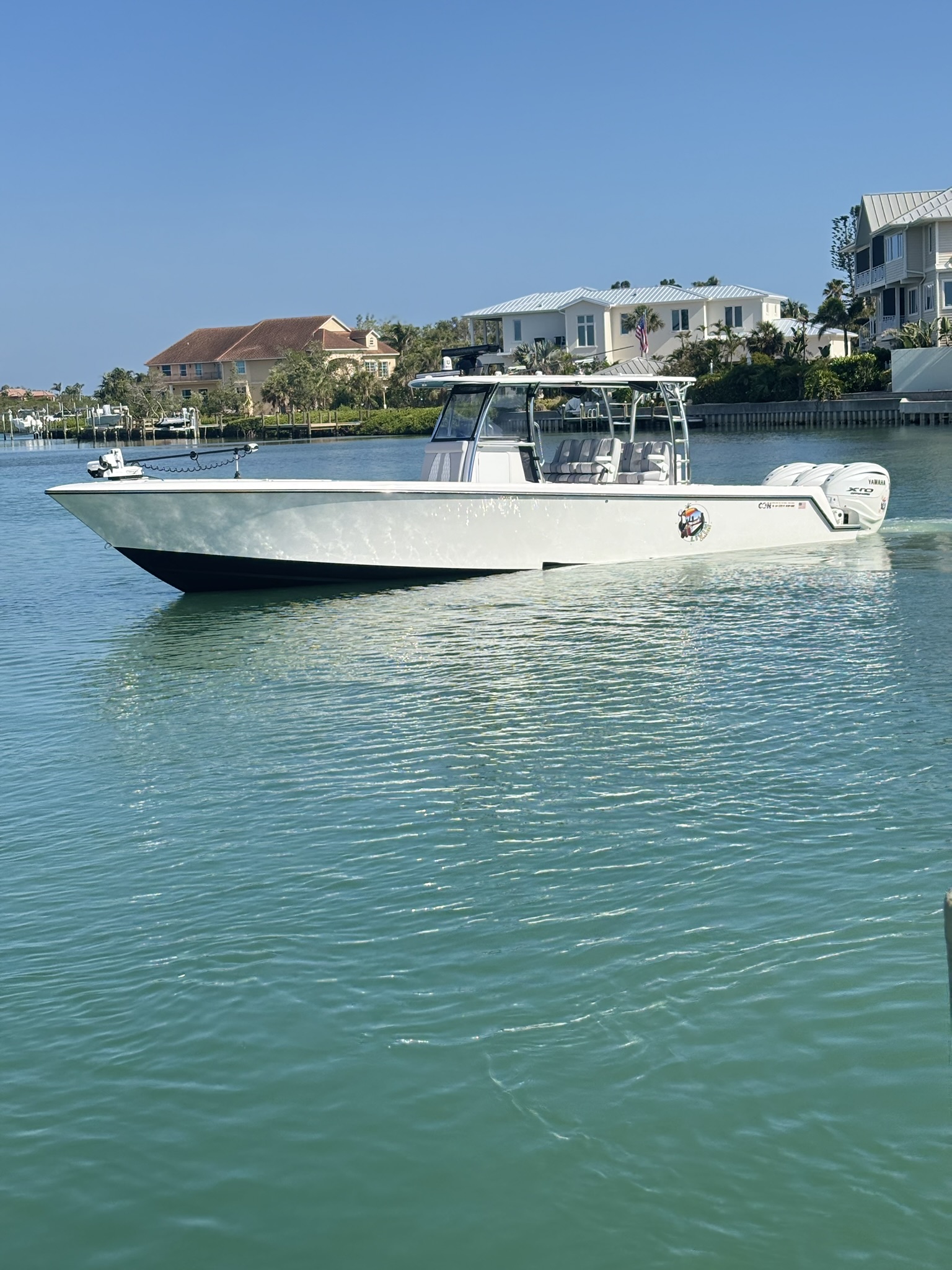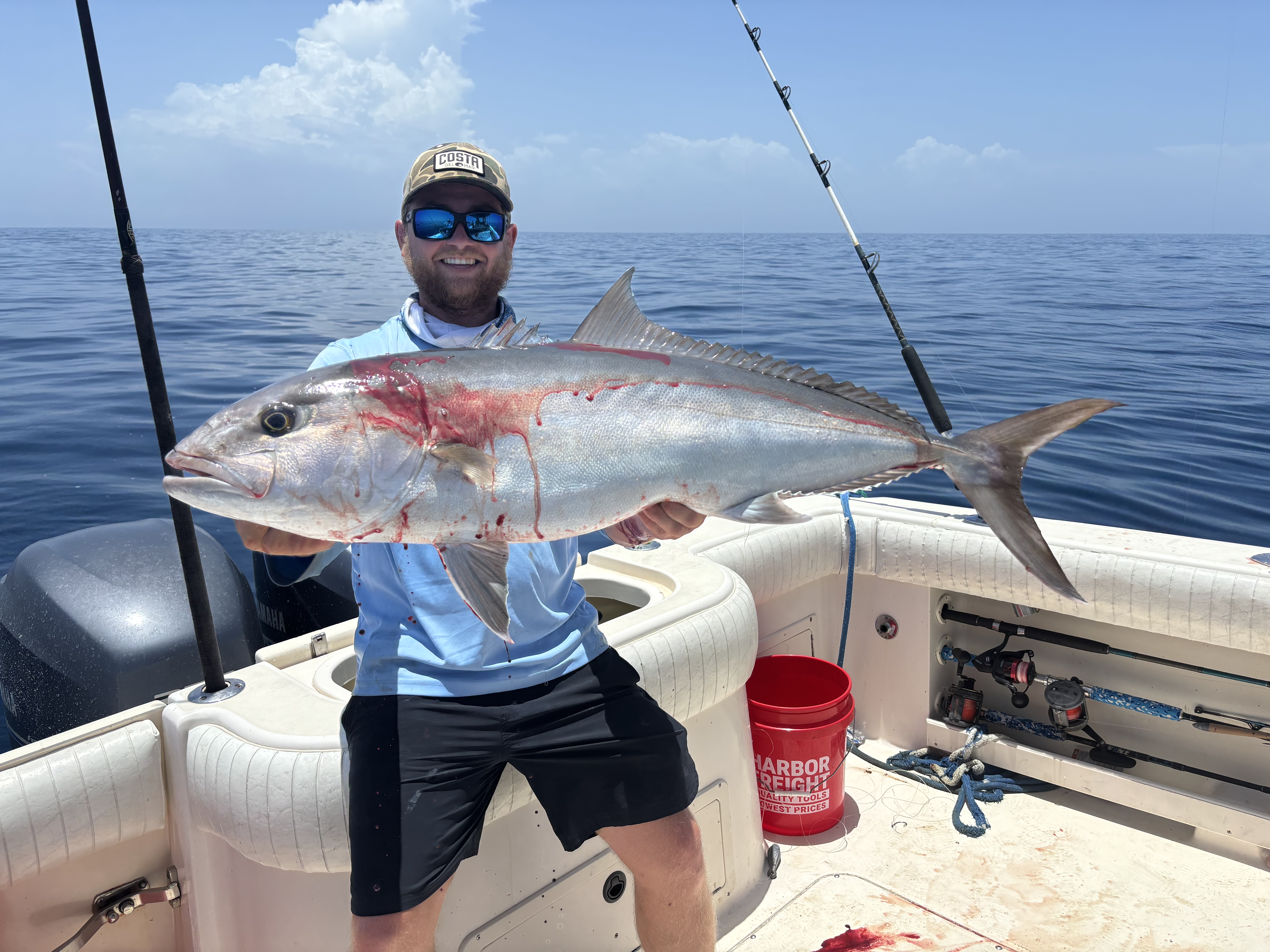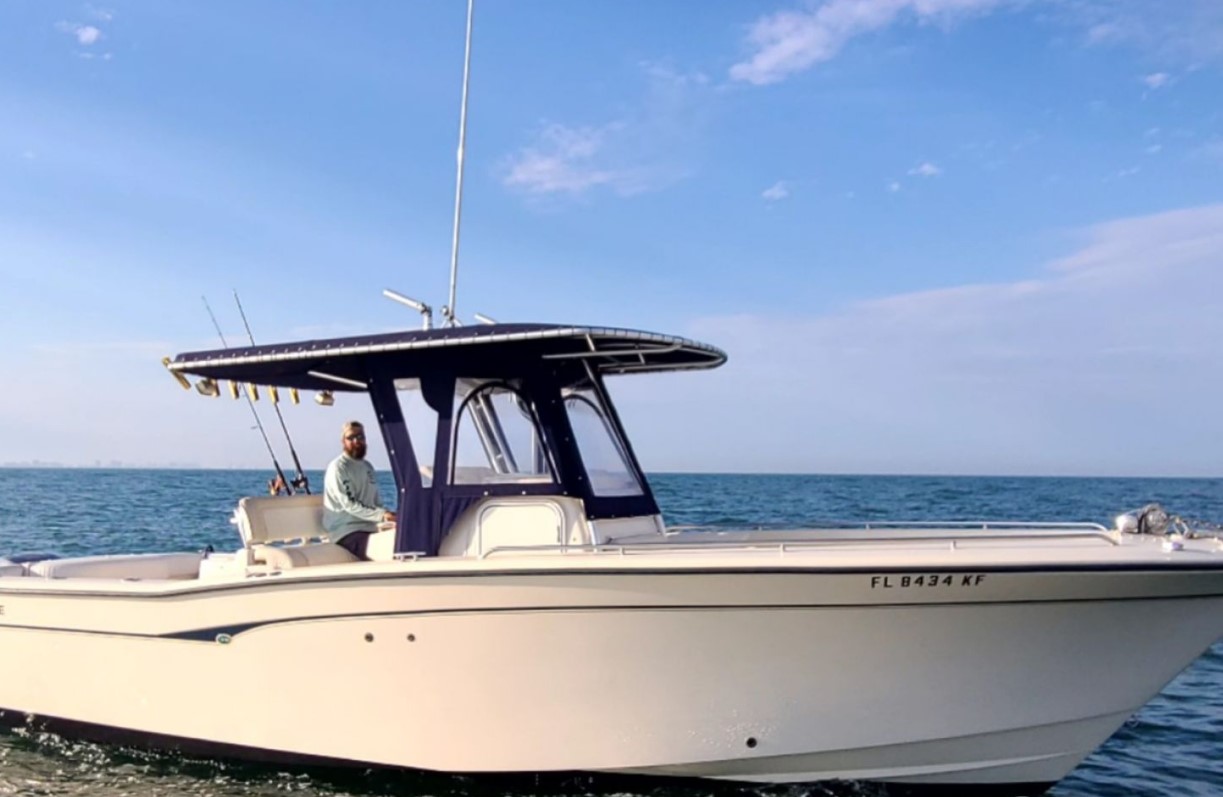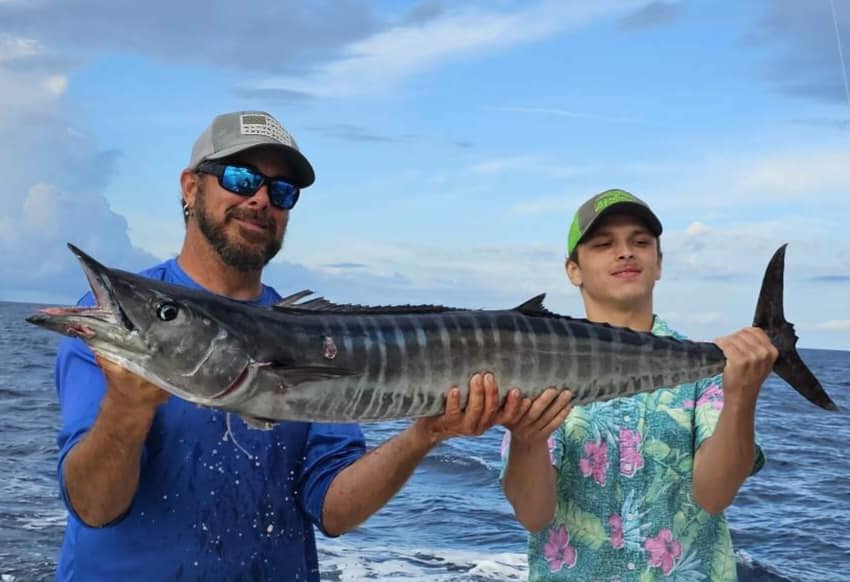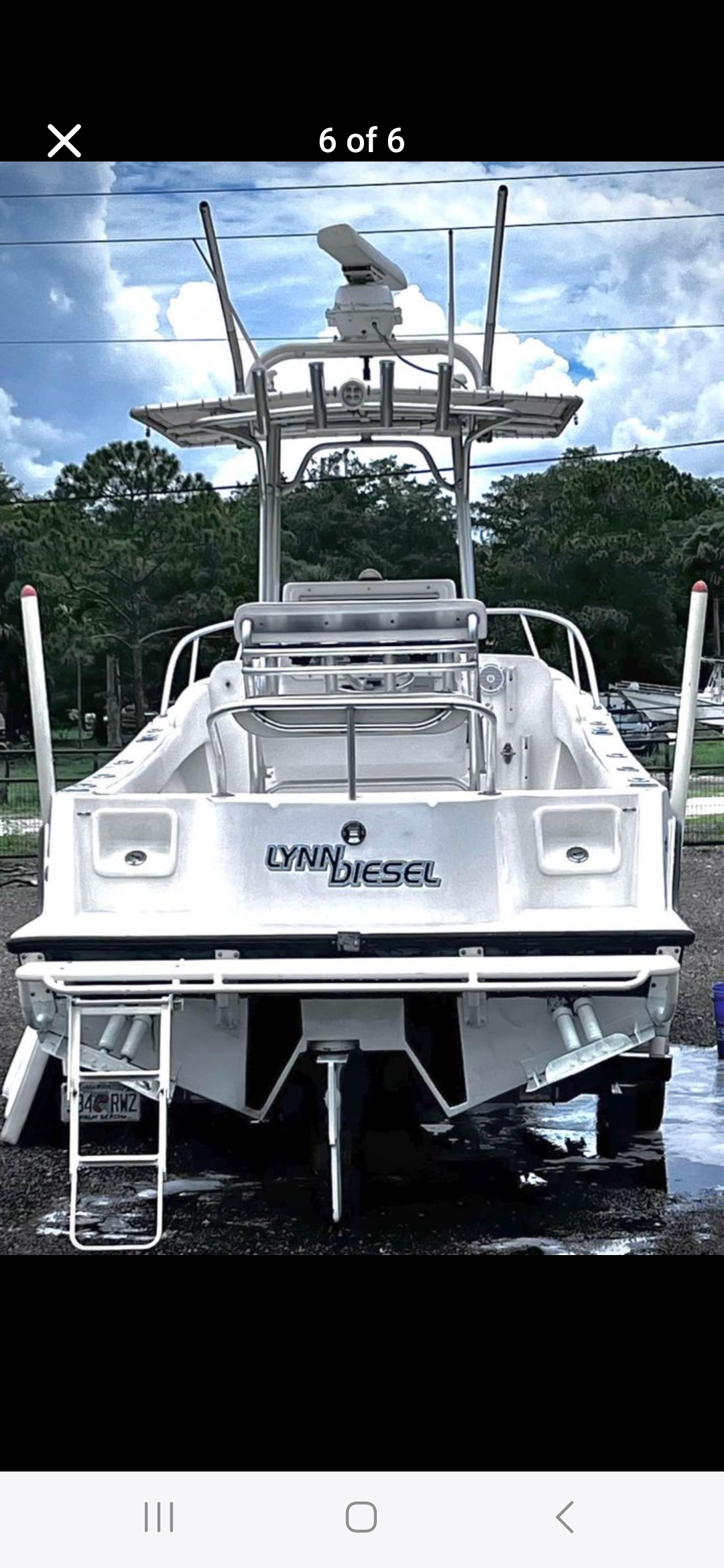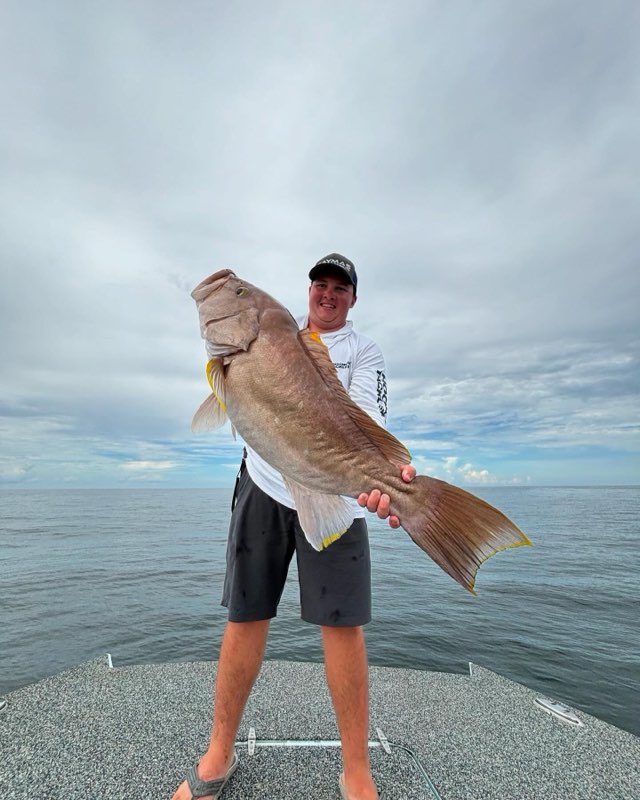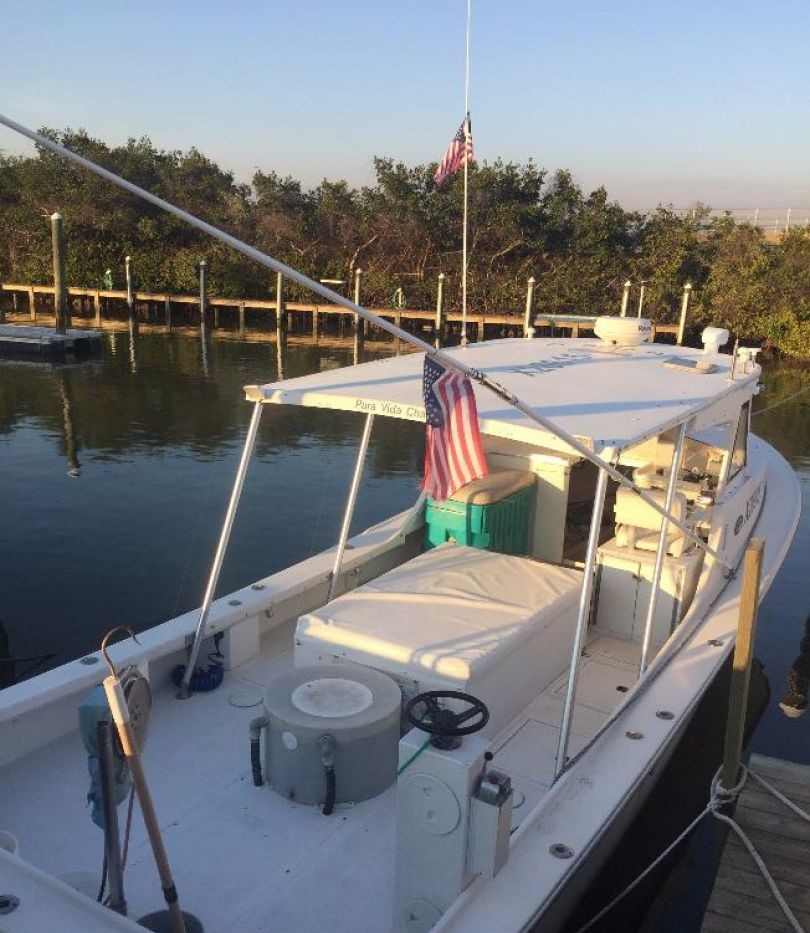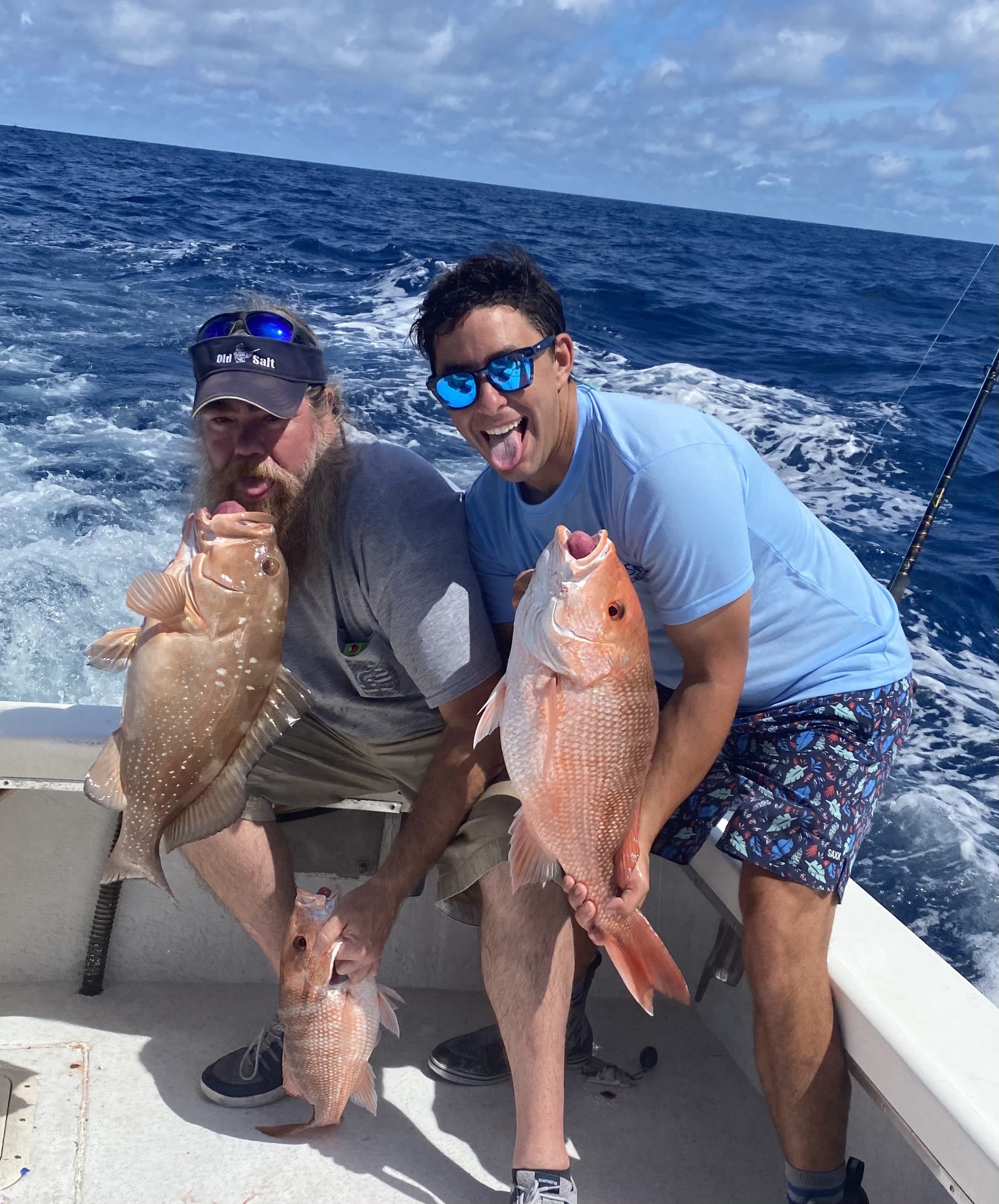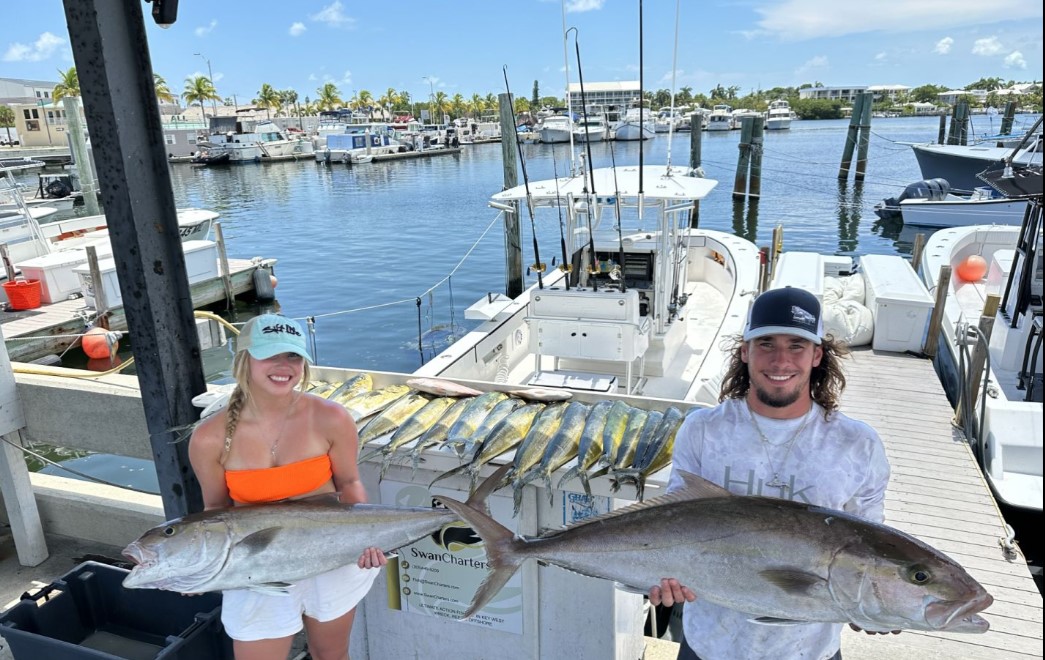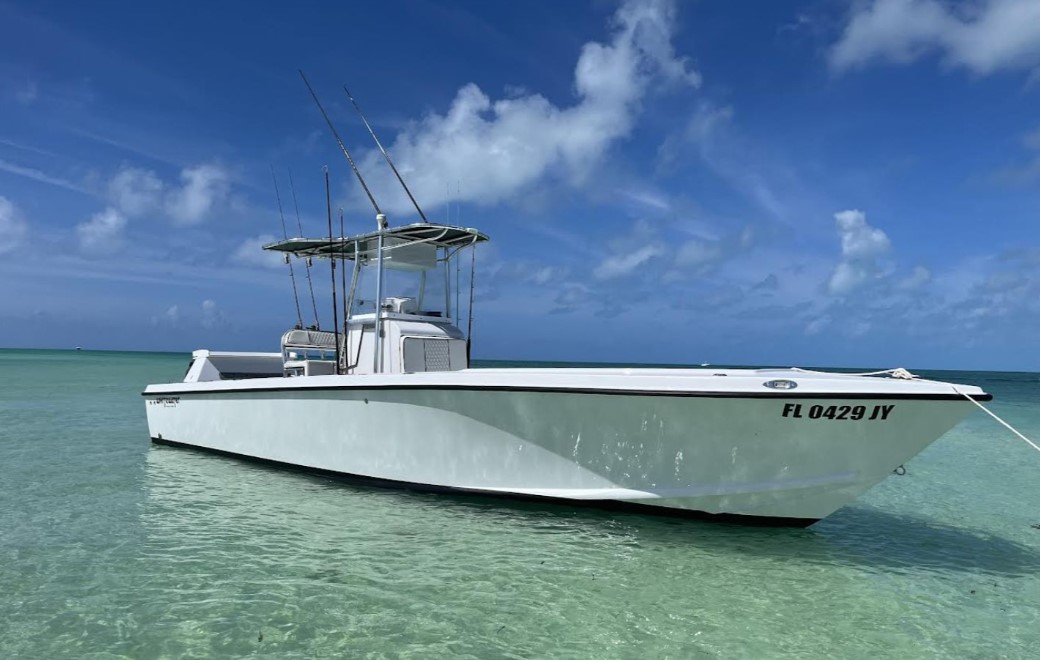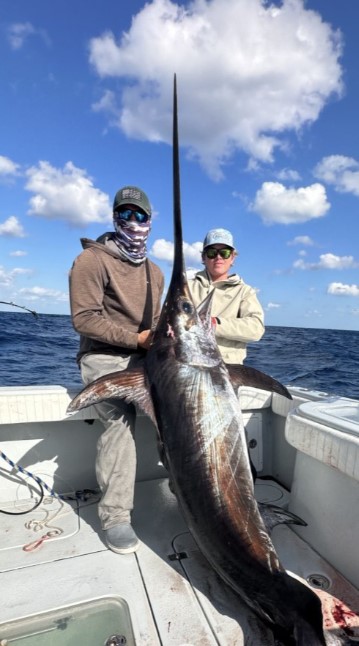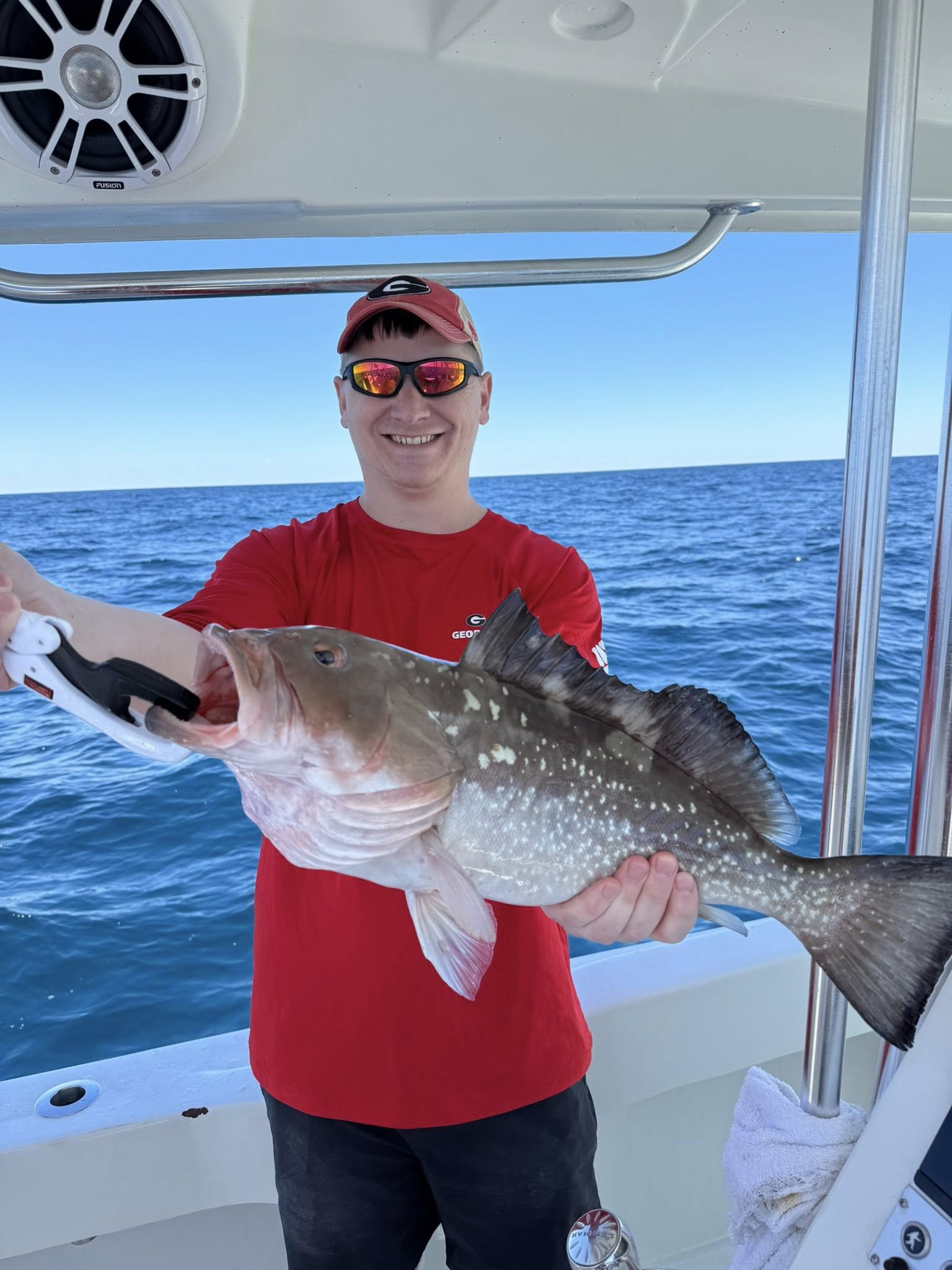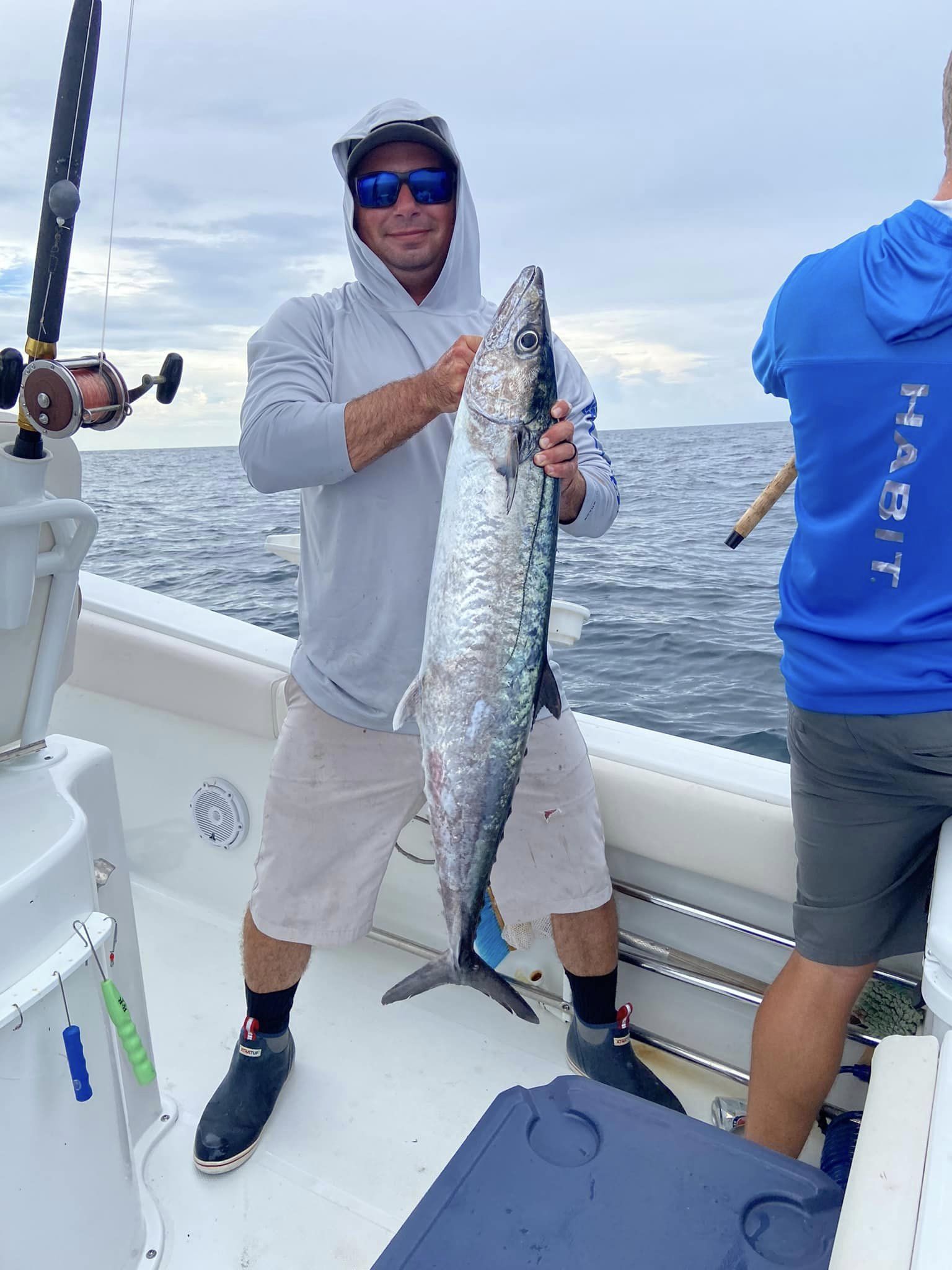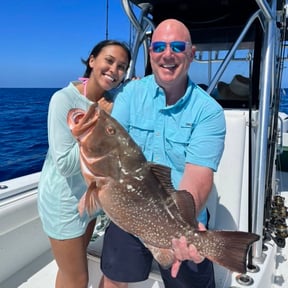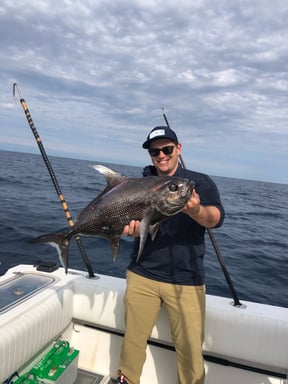Dry Tortugas Multi-Day Trip
Deep Sea, Nearshore, Jetty in Miami
Catch And Cook Sashimi/Grilled Fish
Deep Sea, Nearshore, Jetty in Miami
Miami Sport Fishing 🎣
Deep Sea, Nearshore, Jetty in Miami
Miami Sport Fishing 🎣
Deep Sea, Nearshore Fishing in Nokomis
Nokomis Offshore/Nearshore
Deep Sea Fishing in Port Orange
Extended Day Deep Sea
Nearshore Fishing in Pompano Beach
South FL Nearshore Reef Fishing
Deep Sea, Nearshore Fishing in St. Petersburg
St. Pete Offshore Experience
Deep Sea, Nearshore Fishing in Key West
Ultimate Action Fishing
Deep Sea Fishing in Panama City
10 Hour Federal Deep Water Trip
We started Captain Experiences to make it easy to book fishing and hunting guides around the world. With over 2,000 Damn Good Guides, our platform makes finding and booking a trip seamless. Head here to check out our trips.
What is a Grouper?
Grouper is a general name typically used for fish in the generas Epinephelus, Mycteroperca, and several other smaller genera. Grouper are a diverse group of fish that can vary in appearance but they typically have a stout body similar in shape to snapper and a large mouth for catching prey. They range in size from several hundred pounds down to only a few pounds.
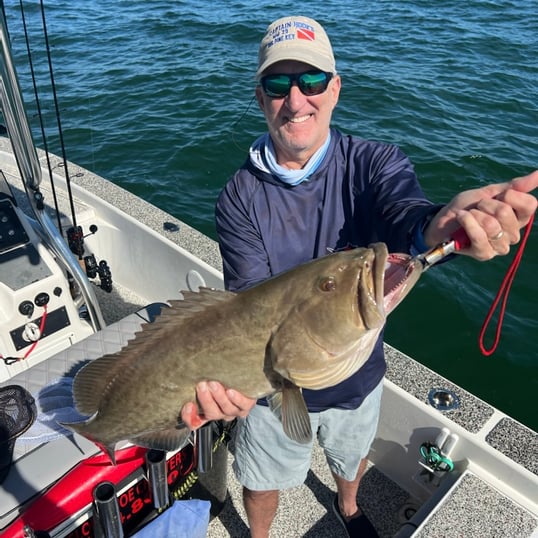
Interestingly enough, most grouper species are protogynous hermaphrodites, which means they change sex after birth. Grouper are typically born female and transition to males sometime after reaching maturity.
How to Catch Grouper
Grouper are not built for covering long distances or to chase down prey with a burst of speed like pelagic species. Instead, they ambush prey or scavenge for easy meals. The large mouth and powerful gills of a grouper create an intense vacuum that pulls prey in. Bottom fishing and in some cases deep dropping are the most effective methods to catch grouper. While artificial lures and baits can work, natural baits are particularly more effective for these fish. With most grouper inhabiting various structures, their most common food sources are crustaceans, fish, and occasionally squid.
For a better understanding of the grouper anglers can expect to catch in the Atlantic and Gulf of Mexico, here is a breakdown of the most prominent species and their federal regulations.
Goliath Grouper
The goliath grouper is the largest grouper species and in the Atlantic Ocean can be found from Florida to Brazil. This titanic fish can grow over eight feet long and weigh up to 800 lbs but surprisingly, these monster fish generally live in less than 150 feet of water which is shallow for a grouper. Goliath grouper have elongated bodies which can range in color from brown and grey to green with black dots on their fins, body, and head. The head of this big fish is wide, tapered, and slightly flattened. The largest goliath grouper to be weighed came in at 880 pounds and a length 7 feet 11 inches.
Goliath Grouper Regulations
The Florida Fish and Wildlife Conservation Commission has passed regulations that will reopen fishing for goliath grouper for the first time in 32 years. The new rules require anglers looking to catch a goliath grouper to get a tag. Harvest will be limited to 200 fish and anglers will only be allowed to keep one fish between 24 and 36 inches. The new season was voted on and ratified on March 3rd, 2022 but the season will not open until March of 2023. Florida’s decision to lift the ban on fishing for goliath grouper has been controversial since it was proposed because of how vulnerable this species is to extinction.
Nassau Grouper
Nassau are a moderate-sized grouper with big eyes and a stocky body. The appearance of this fish is most commonly tan or beige with five brown vertical stripes. Their most distinct markings are a black blotch on top of the base of their tail and black spots behind each eye.
They can be distinguished from other groupers by the vertical bars and dark saddle coloring along the dorsal part of the area preceding the tail. Nassau grouper can change their color pattern rapidly from washed out and dull to vivid detailed markings and even uniformly dark. A distinctive two-tone color pattern appears when two adults meet and occurs most often during spawning.
Nassau grouper are ambush predators which indiscriminately prey on smaller creatures. The size of prey nassau chose to eat is limited only by the size of their mouth. Adults nassau usually feed exclusively on fish, while smaller fish will eat other fish and invertebrates.
Nassau Regulations
At one time, nassau grouper were one of the most numerous grouper species in the U.S. After years of being commercially overfished, nassau grouper numbers dwindled. To aid in their recovery, all harvest of Nassau grouper is banned in the United States.
Gag Grouper
Gag grouper have long, compressed bodies that are common for most grouper species. The greek name for gag grouper means small scale which refers to the tiny scales that cover their body. The coloration of this fish varies with age and size. Large gag are dark brown to gray on the top half of their body. The bottom half of their body is lighter with faint wavy markings on their sides. Typically, smaller younger fish are lighter in color but have darker brown marks along their sides.
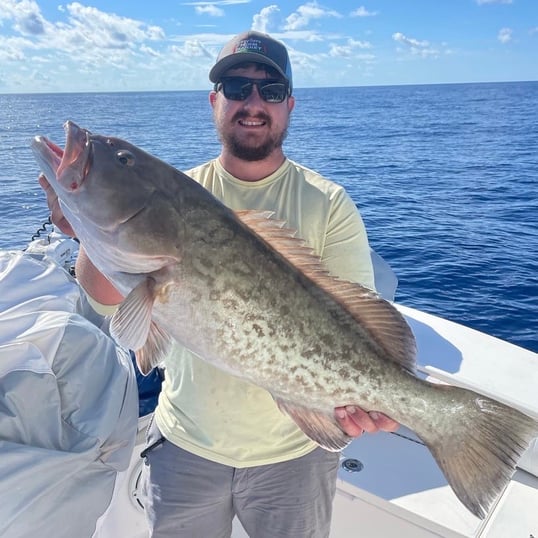
There are two population of gag grouper: one in the South Atlantic and another in the Gulf of Mexico. The most recent assessments show that both populations are overfished despite their population status being least concern.
Gag grouper grow slowly but with a lifespan of 30 years, they can reach more than 3 feet in length, and over 40 pounds.Like most grouper species, gag grouper eat a wide variety of fish, crabs, shrimp, and squid.
Gag Grouper Regulations
Atlantic Gag Grouper Season 2023
Gag grouper season is closed from January 1, 2023 to April 30, 2023.
Bag Limit
Anglers may harvest 1 gag grouper as part of their 3 grouper aggregate limit.
Minimum Size Requirement:
24 inches in total length.
Gulf of Mexico Gag Grouper Season 2023
Gag Grouper season is closed from January 1, 2023 to August 31, 2023 and November 11, 2023 to August 31, 2024.
Bag Limit
Anglers may harvest up to 2 gag grouper as part of their 4 grouper aggregate limit.
Minimum size Requirement:
24 inches total length.
Black Grouper
The black grouper has round cheeks and an olive colored body with dark blotches and gold to yellow spots. This species of grouper is capable of growing huge over the course of their 30 year life span. Black grouper can grow up to five feet long and can weigh as much as 180 pounds. These are solitary fish but from May through August they form large groups to spawn.
When black grouper are young they primarily feed on shrimp or other crustaceans. Once they reach adulthood, black grouper feed on squid and any fish that will fit in their mouth. Black grouper have large, powerful jaws that they use to ambush their prey. They don’t have teeth in their mouth but they do have teeth plates in their throat which secure prey.
The Gulf of Mexico and South Atlantic stocks are not overfished according to the 2010 stock assessment. The black grouper populations are at or above their target level in the Gulf of Mexico and South Atlantic.
Black Grouper Regulations
Atlantic Black Grouper Season 2023
Black grouper season is closed from January 1, 2023 to April 30, 2023.
Bag Limit
Anglers may harvest 1 black grouper as part of their 3 grouper aggregate limit.
Minimum Size Requirement
24 inches in total length.
Gulf of Mexico Black Grouper Season 2023
Black Grouper season is closed from February 1, 2023 to March 31, 2023.
Bag Limit
Anglers may harvest up to 4 black grouper as part of their 4 grouper aggregate limit.
Minimum size:
24 inches total length.
Red Grouper
Red grouper have robust bodies with small scales. Their head and body are an inconsistent mix of red and brown which can sometimes appear orange. This fish also has white spots down the sides and black spots on their cheeks. Red grouper spawn approximately 26 times a year, in shallow waters from February through June.
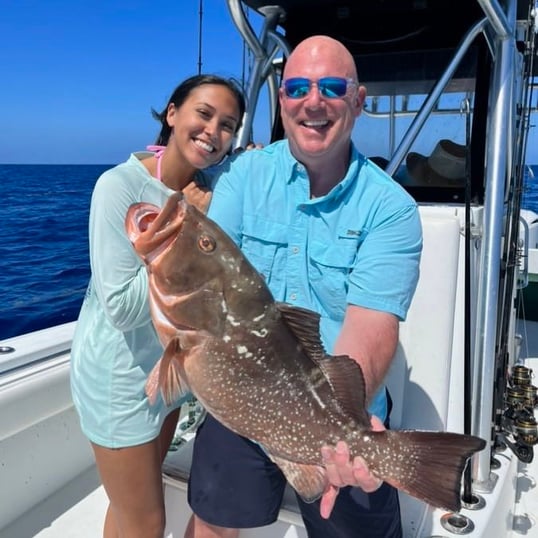
The red grouper’s lower jaw extends slightly further than their upper jaw and features bands of sharp narrow teeth. This species grows slowly, but given enough time they can become giant. Red grouper are known to reach up to 50 inches long and more than 50 pounds.
Red grouper like most grouper are opportunistic feeders and will eat any convenient prey. Typically, red grouper eat a variety of fish, octopus, shrimp, and lobster. They are among the top predators in a reef environment and are only preyed upon by sharks.
There are two stocks of red grouper: the Gulf of Mexico stock and the South Atlantic stock. According to the most recent stock assessments red grouper are above target population level in the Gulf of Mexico. Significantly below target population level in the South Atlantic. A rebuilding plan is in place for the South Atlantic stock.
Red Grouper Regulations
Atlantic Red Grouper Season 2023
Red grouper season is closed from January 1, 2023 to April 30, 2023.
Atlantic Bag Limit
Anglers may harvest up to 3 red grouper as part of their 3 grouper aggregate limit.
Minimum Size Requirement:
20 inches in total length.
Gulf of Mexico Red Grouper Season 2023
Red grouper season is closed from February 1, 2023 to March 31, 2023.
Bag Limit
Anglers may harvest up to 2 red grouper as part of their 4 grouper aggregate limit.
Minimum Size Requirement:
20 inches total length.
Scamp Grouper
The scamp grouper has a stout elongated body and subtly concave tail. The coloration of this grouper species can vary between four different phases. The first phase is a brown coloration with numerous blotchy brown spots. These spots also appear on their fins and the tail features a purple edge.The second phase is similar to the first but with a more faded brown color and with larger more blotchy spots that resemble paw prints.
The third phase typically occurs on large adults and has a grey colored head and front of the body with the rest of the body being much darker. The fourth phase also has a few white spots on the body and at the base of the tail. Scamp grouper can grow up to 42 inches long and a maximum weight of 31 pounds. However, most scamp that get caught are around 12 inches long.
This grouper species is commonly found at depths of up to 350 feet and prefer rocky areas. Ocean floor geography with high relief around 100 feet deep are an ideal place to find them. Younger scamp hang out in shallower reefs and will occasionally enter estuaries and mangroves. When the temperature drops at the bottom of the water column adult scamp grouper temporarily form spawning groups near offshore reefs.
Scamp Grouper Regulations
Atlantic Scamp Grouper Season 2023
Scamp grouper season is closed from January 1, 2023 to April 30, 2023.
Atlantic Ocean Bag Limit
Anglers may harvest up to 3 scamp grouper as part of their 3 grouper aggregate limit.
Minimum Size Requirement:
20 inches total length.
Gulf of Mexico Scamp Grouper Season 2023
Grouper season is closed from February 1, 2023 to March 31, 2023.
Gulf of Mexico Bag Limit
Anglers may harvest up to 4 scamp grouper as part of their 4 grouper aggregate limit.
Minimum Size Requirement:
16 inches total length.
Yellowfin Grouper
The yellowfin grouper has a similar body shape to other grouper species and has either a red or green coloration. The red coloration occurs in deep water populations while the green coloration occurs in shallower waters. The tail fin of the yellowfin grouper is straight on juvenile fish and slightly concave in adults. Oblong clusters of dark spots are present on the head and the edge of the pectoral fins is bright yellow.
This species is a mid-sized grouper reaching a maximum length of 39 inches and 41 pounds. Most yellowfin grouper caught by anglers are around 18 inches.
The yellowfin grouper’s preferred habitat is rock structures and coral reefs in waters up to 450 feet deep. Juvenile fish hangout in shallow water in and around beds of turtle glass. Yellowfin grouper primarily eat other fish but will also eat squid given the opportunity.
Yellowfin Grouper Regulations
Atlantic Yellowfin Grouper Season 2023
Yellowfin grouper season is closed from January 1, 2023 to April 30, 2023.
Atlantic Ocean Bag Limit
Anglers may harvest up to 3 yellowfin grouper as part of their 3 grouper aggregate limit.
Minimum Size Requirement:
20 inches in total length.
Gulf of Mexico Yellowfin Grouper Season 2023
Yellowfin Grouper season is closed from February 1, 2023 to March 31, 2023.
Gulf of Mexico Bag Limit
Anglers may harvest up to 4 yellowfin grouper as part of their 4 grouper aggregate limit.
Minimum Size Requirement:
20 inches in total length.
Yellowmouth Grouper
The yellowmouth grouper has a similar body shape and yellow markings to the yellowfin grouper.The tail fin is also similarly rounded and slightly concave. Differences begin with vastly different coloration. Adult yellowmouth grouper are brown to grey with small brown spots on the top half of their body. Occasionally these fish also feature dark vertical bars. The yellow marking are more localized on the yellowmouth grouper with distinct yellow coloration on the edge of the dorsal and tail fins. The most prominent yellow color is found in and around their mouth which gives them their name.
The yellowmouth grouper is a moderately sized grouper reaching a maximum length of 33 inches and weight up to 22 pounds. While yellowmouth grouper can reach almost three feet in length, they typically average around 16 inches. Yellowmouth are commonly found near rocky structures and reefs primarily feeding on silversides and striped parrotfish. These grouper can be found around structures down to 180 feet.
Yellowmouth Grouper Regulations
Atlantic Yellowmouth Grouper Season 2023
Yellowmouth grouper season is closed from January 1, 2023 to April 30, 2023.
Atlantic Ocean Bag Limit
Anglers may harvest up to 3 yellowmouth grouper as part of their 3 grouper aggregate limit.
Minimum Size Requirement:
20 inches in total length.
Gulf of Mexico Yellowmouth Grouper Season 2023
There is currently no closed season for yellowmouth grouper in the Gulf of Mexico.
Gulf of Mexico Bag Limit
Anglers may harvest up to 4 yellowmouth grouper as part of their 4 grouper aggregate limit.
Red Hind
The red hind has a compressed body which is deepest at the start of the dorsal fin with a slightly convex tail. Their coloration is a dull green to light brown which fades to white on its belly. The red hind has many dull orange to brown spots on their body and fins. This fish also has five indistinct vertical bars which consist of dark spots on their sides. The red hind is capable to growing to 30 inches long and 49 pounds but they are more commonly caught at around 16 inches. Like most grouper species red hind’s inhabit coral reefs and rock structures. Female red hinds stay close to the bottom or structure while the males remain shallower and defend their range and harem of up to five females. The primary forage for red hind is fish, shrimp, crabs, and octopus.
Red Hind Regulations
Atlantic Red Hind Season 2023
Red hind season is closed from January 1, 2023 to April 30, 2023.
Atlantic Ocean Bag Limit
Anglers may harvest up to 3 red hind as part of their 3 grouper aggregate limit.
Gulf of Mexico Red Hind
The red hind is not federally regulated in the Gulf of Mexico. Anglers are required to follow the state regulations.
Rock Hind
Like other grouper species, rock hinds can vary in color but are frequently brown to tan with red to brown spots on their body, fins and tails. The Rock Hind’s spots are similar to the red hind but have one or more distinct dark blotches. Rock hind’s are widespread in the Atlantic Ocean and Gulf of Mexico. These fish are often found with the red hind. Rock hinds are one of the most common groupers and commonly live near jetties.
Rock Hind Regulations
Atlantic Rock Hind Season 2023
Rock hind season is closed from January 1, 2023 to April 30, 2023.
Atlantic Ocean Bag Limit
Anglers may harvest up to 3 rock hind as part of their 3 grouper aggregate limit.
Coney Grouper
The coney grouper’s body and fins are deep red, orange, or yellow in color and speckled with small spots. These spots are a bright reflective blue and contrasted by black outline. Coney grouper can commonly be found in shallow water, but also spend time in deeper waters. The depth at which a grouper is found is responsible for the varying colors. The deep red color is found in deep water fish while the yellow color is more common in shallow water fish. The orange color phase occurs as a transition between shallow and deep waters.
The area behind the dorsal fin but before the tail has 2 prominent black spots that are distinct to this species. Unlike most grouper species that have a concave or squared off tail, coney grouper have a convex or rounded tail fin.
The coney grouper can be found from the Carolinas south to Florida and prefer to inhabit clear water reefs. They usually take shelter near rocky cavernous structures or under ledges at depths of up to 230 feet, but rarely free swim in the water column. The coney grouper is predatory and primarily feeds on crustaceans and fish. This species can be seen following eels to pick off easy meals.
Coney grouper are capable of reaching 17 inches long and up to 12 pounds. However, most coney grouper caught are around 8 to 12 inches long. This fish is thought to grow up to 60% of their maximum size during their first year, but the growth rate drops off significantly after that.
Coney Grouper Regulations
Atlantic Coney Grouper Season 2023
Coney grouper season is closed from January 1, 2023 to April 30, 2023.
Bag Limit
Anglers may harvest up to 3 coney grouper as part of the 3 grouper aggregate limit in Atlantic Federal waters.
Graysby Grouper
The Graysby is similar in size to the coney grouper with a maximum size of 16 inches long and 2.5 pounds. The average graysby grouper is around 8 inches long but its markings and coloration are distinct. Graysby grouper range from gray to brown and have orange to maroon spots on its body and fins. This fish also has three to five spots just below the dorsal fin. Another distinctive mark of the graysby grouper is the white line that runs between its eyes. The spots on the fish’s sides will also become lighter or darker as it grows. The tail is more rounded than in similar species. The range of the Graysby grouper runs from North Carolina to Southern Florida and beyond.
Being one of the smaller grouper species, this fish prefers to live in rocky outcropping and caves along coral reefs between 10 and 60 feet. Coral reefs allow these spotted fish to blend in and hide amongst the rocks.
Graysby Grouper Regulations
Atlantic Graysby Grouper Season 2023
Graysby grouper season is closed from January 1, 2023 to April 30, 2023.
Atlantic Ocean Bag Limit
Anglers may harvest up to 3 graysby grouper as part of their 3 grouper aggregate limit.
Yellowedge Grouper
The yellowedge grouper inhabits waters in the Atlantic and Gulf of Mexico and grow to considerable size. Yellowedge range from grey or tan to brown in color fade to white on its belly. This fish also has a blue line that extends from the eyes to the bottom edge of the cheek. The distinctive yellow coloration occurs on the the dorsal, pectoral, and sometimes tail fins.
The yellowedge grouper reaches maturity at 6 to 8 year old but is capable of living up to 85 years. During the course of their life they can grow to almost 4 feet long and 50 pounds. However, yellowedge grouper typically only grow to around 30 inches long and 10 pounds.
Yellowedge grouper tend to be solitary and inhabit rocky and sandy bottoms or coral reefs. In soft-bottomed areas this grouper will dig and inhabit burrows. This fish is typically found at depths between 400 and 1000 feet. Yellowedge grouper aggregate to spawn from late winter to late fall in the Gulf. The peak of spawning activity occurs from March to September.
Yellowedge Grouper Regulations
Atlantic Yellowedge Grouper Season 2023
There is currently no federally closed season for yellowedge grouper in the Atlantic.
Atlantic Ocean Bag Limit
Anglers may harvest up to 3 yellowedge grouper as part of their 3 grouper aggregate limit.
Gulf of Mexico Yellowedge Grouper Season 2023
There is currently no closed season for yellowedge grouper in the Gulf of Mexico.
Gulf of Mexico Bag Limit
Anglers may harvest up to 4 yellowedge grouper as part of their 4 grouper aggregate limit.
Misty Grouper
Misty Grouper are one of the largest grouper species and feature a two tone brown coloration. Their body shape is deep and compressed like many other grouper species but their stripes help distinguish them from other species. Misty grouper have 6 to 9 distinct dark brown vertical bars over a tan background. This grouper is found along the Atlantic and Gulf Coasts in the United States but its range extends far beyond that.
The misty grouper prefers deeper waters around 500 feet. Like other groupers, the misty grouper prefers to inhabit rock ledges, hard bottoms, and reefs. The size of the misty grouper is impressive with fish being documented at over 5 feet long and weights of more than 100 pounds.
Misty Grouper Regulations
Atlantic Misty Grouper Season 2023
There is currently no closed season for misty grouper in Atlantic Federal Waters.
Atlantic Ocean Bag Limit
Anglers may harvest up to 3 misty grouper as part of their 3 grouper aggregate limit.
Gulf of Mexico Misty Grouper
Misty grouper are not federally regulated in the Gulf of Mexico. All state regulations apply.
Warsaw Grouper
The warsaw grouper is another deep-water grouper that grows to a formidable size. This fish inhabits reefs, wrecks, and rocky structures along the continental shelf. Depths along the shelf range from 200 to almost 1800 ft deep.
Warsaw grouper are reddish-brown to pale brown on the top half of their body. Along their dorsal fin they can be almost black but along their belly it fades to a faintly red, grey color. The warsaw grouper can be quickly distinguished from other grouper species because it is the only grouper with 10 dorsal spines.
As one of the largest grouper species it can reach over 8 feet long. One warsaw grouper caught in florida weighed 350 pounds and was estimated to be more than 50 years old. Due to the extreme depths that warsaw grouper live at, catching one of these fish can be damaging to their swim bladder. Depending on the organization the warsaw grouper is currently listed as either threatened or endangered.
Warsaw Grouper Regulations
Gulf of Mexico Warsaw Grouper Season 2023
There is currently no closed season for warsaw grouper in the Gulf of Mexico.
Gulf of Mexico Bag Limit
Anglers may harvest 1 warsaw grouper as part of their 4 grouper aggregate limit. Warsaw grouper are also subject to a vessel limit of one fish.
Speckled Hind
The speckled hind gets its name from the array of white spots that cover their deep reddish to body. Occasionally younger speckled hind’s will show a yellow color phase with white spots. This is a moderately size grouper species capable of growing to over 40 inches and 64 pounds. As one of the smaller grouper, speckled hinds tend to inhabit shallower waters. Speckled hind inhabit warm water of moderate depth between 150 to 350 feet. Their range extends from North Carolina through the Gulf of Mexico to the Bahamas. The Preferred habitat of speckled hind include hard rocky or sandy bottoms and reefs. Like many other reef fish, speckled hind there is a relationship between water depth and fish size with larger fish inhabiting deeper waters. The speckled hind reaches sexual maturity at 4 to five years old and can live up to 25 years. Speckled hind go further offshore to spawn which occurs from July to September.
Speckled Hind Regulations
Gulf of Mexico Speckled Hind Season 2023
There is currently no closed seas for speckled hind in the Gulf of Mexico.
Gulf of Mexico Bag Limit
Anglers may harvest 1 speckled hind as part of their 4 grouper aggregate limit. Speckled hind are also subject to a vessel limit of one fish.
Snowy Grouper
Snowy grouper are found in the Atlantic from Massachusetts south to the Gulf of Mexico and into the Caribbean. This is one of the least showy species of grouper with a solid brown coloration. Younger fish can have evenly spaced white spots on their sides and back or a dark blotch at the base of their tail. Sometimes these juvenile fish can have yellow on their pectoral and tail fins which can make them look similar to yellowedge grouper.
The snowy grouper reaches maturity at 5 years old and has been documented to live up to 35 years. During the course of their life they grow to four feet long and weigh as much as 66 pounds. The habitat this fish inhabits is similar to other grouper species but is less specific. Snowy grouper can be found over hard bottoms, rocky structures, and reefs at depths from 50 to 1,200 feet.
Snowy grouper have been observed to exhibit courtship behavior near deep coral reefs where scamp and gag grouper also aggregate to spawn. Snowy grouper will aggregate to spawn from January to October in the Gulf of Mexico.
Snowy Grouper Regulations
Atlantic Snowy Grouper Season 2023
Snowy grouper season is closed from September 1, 2022 to April 30, 2023.
Atlantic Ocean Bag Limit
Anglers may harvest 1 snowy grouper as part of the 3 grouper aggregate limit. Snowy grouper are also subject to a vessel limit of one fish.
Gulf of Mexico Snowy Grouper Season 2023
There is currently no closed season for snowy grouper in the Gulf of Mexico.
Gulf of Mexico Bag Limit
Anglers may harvest up to 4 snowy grouper as part of the 4 grouper aggregate limit.
Joey Butrus
Updated on January 25, 2023
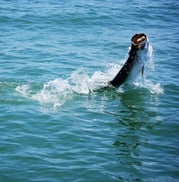
April 15, 2022

July 31, 2024
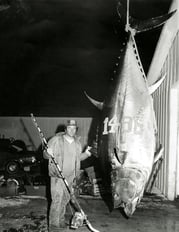
June 3, 2021
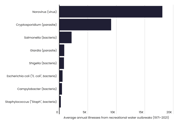
July 1, 2024

May 13, 2024
Related Articles
January 13, 2023
August 2, 2023
June 26, 2023
Featured Locations
- Fishing Charters Near Me
- Austin Fishing Guides
- Biloxi Fishing Charters
- Bradenton Fishing Charters
- Cabo San Lucas Fishing Charters
- Cancun Fishing Charters
- Cape Coral Fishing Charters
- Charleston Fishing Charters
- Clearwater Fishing Charters
- Corpus Christi Fishing Charters
- Crystal River Fishing Charters
- Dauphin Island Fishing Charters
- Daytona Beach Fishing Charters
- Destin Fishing Charters
- Fort Lauderdale Fishing Charters
- Fort Myers Fishing Charters
- Fort Walton Beach Fishing Charters
- Galveston Fishing Charters
- Gulf Shores Fishing Charters
- Hatteras Fishing Charters
- Hilton Head Fishing Charters
- Islamorada Fishing Charters
- Jacksonville Fishing Charters
- Jupiter Fishing Charters
- Key Largo Fishing Charters
- Key West Fishing Charters
- Kona Fishing Charters
- Lakeside Marblehead Fishing Charters
- Marathon Fishing Charters
- Marco Island Fishing Charters
- Miami Fishing Charters
- Montauk Fishing Charters
- Morehead City Fishing Charters
- Naples Fishing Charters
- New Orleans Fishing Charters
- New Smyrna Beach Fishing Charters
- Ocean City Fishing Charters
- Orange Beach Fishing Charters
- Panama City Beach Fishing Charters
- Pensacola Fishing Charters
- Pompano Beach Fishing Charters
- Port Aransas Fishing Charters
- Port Orange Fishing Charters
- Rockport Fishing Charters
- San Diego Fishing Charters
- San Juan Fishing Charters
- Sarasota Fishing Charters
- South Padre Island Fishing Charters
- St. Augustine Fishing Charters
- St. Petersburg Fishing Charters
- Tampa Fishing Charters
- Tarpon Springs Fishing Charters
- Venice Fishing Charters
- Virginia Beach Fishing Charters
- West Palm Beach Fishing Charters
- Wilmington Fishing Charters
- Wrightsville Beach Fishing Charters
